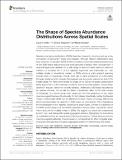Files in this item
The shape of species abundance distributions across spatial scales
Item metadata
| dc.contributor.author | Antão, Laura H. | |
| dc.contributor.author | Magurran, Anne E. | |
| dc.contributor.author | Dornelas, Maria | |
| dc.date.accessioned | 2021-04-21T12:30:08Z | |
| dc.date.available | 2021-04-21T12:30:08Z | |
| dc.date.issued | 2021-04-07 | |
| dc.identifier | 273899262 | |
| dc.identifier | 46fcfd01-aa8d-4266-8cd4-9e408978d944 | |
| dc.identifier | 85104669196 | |
| dc.identifier | 000641577200001 | |
| dc.identifier.citation | Antão , L H , Magurran , A E & Dornelas , M 2021 , ' The shape of species abundance distributions across spatial scales ' , Frontiers in Ecology and Evolution , vol. 9 , 626730 . https://doi.org/10.3389/fevo.2021.626730 | en |
| dc.identifier.issn | 2296-701X | |
| dc.identifier.other | Jisc: 5767c552f1f8483eacfd25f903cda619 | |
| dc.identifier.other | ORCID: /0000-0002-0036-2795/work/92775255 | |
| dc.identifier.other | ORCID: /0000-0001-6612-9366/work/92775323 | |
| dc.identifier.uri | https://hdl.handle.net/10023/23068 | |
| dc.description | Funding: We thank the University of St. Andrews Bioinformatics Unit (Wellcome Trust ISSF grant [105621/Z/14/Z]). The two icons in Figure 2 are from the Noun Project under CCBY license: land by A. Skowalsky, and wave by B. Farias. | en |
| dc.description.abstract | Species abundance distributions (SADs) describe community structure and are a key component of biodiversity theory and research. Although different distributions have been proposed to represent SADs at different scales, a systematic empirical assessment of how SAD shape varies across wide scale gradients is lacking. Here, we examined 11 empirical large-scale datasets for a wide range of taxa and used maximum likelihood methods to compare the fit of the logseries, lognormal, and multimodal (i.e., with multiple modes of abundance) models to SADs across a scale gradient spanning several orders of magnitude. Overall, there was a higher prevalence of multimodality for larger spatial extents, whereas the logseries was exclusively selected as best fit for smaller areas. For many communities the shape of the SAD at the largest spatial extent (either lognormal or multimodal) was conserved across the scale gradient, despite steep declines in area and taxonomic diversity sampled. Additionally, SAD shape was affected by species richness, but we did not detect a systematic effect of the total number of individuals. Our results reveal clear departures from the predictions of two major macroecological theories of biodiversity for SAD shape. Specifically, neither the Neutral Theory of Biodiversity (NTB) nor the Maximum Entropy Theory of Ecology (METE) are able to accommodate the variability in SAD shape we encountered. This is highlighted by the inadequacy of the logseries distribution at larger scales, contrary to predictions of the NTB, and by departures from METE expectation across scales. Importantly, neither theory accounts for multiple modes in SADs. We suggest our results are underpinned by both inter- and intraspecific spatial aggregation patterns, highlighting the importance of spatial distributions as determinants of biodiversity patterns. Critical developments for macroecological biodiversity theories remain in incorporating the effect of spatial scale, ecological heterogeneity and spatial aggregation patterns in determining SAD shape. | |
| dc.format.extent | 11 | |
| dc.format.extent | 1305072 | |
| dc.language.iso | eng | |
| dc.relation.ispartof | Frontiers in Ecology and Evolution | en |
| dc.subject | Ecology and Evolution | en |
| dc.subject | Spatial scale | en |
| dc.subject | Biodiversity | en |
| dc.subject | Community structure | en |
| dc.subject | Multimodality | en |
| dc.subject | Macroecology | en |
| dc.subject | Maximum entropy theory of ecology | en |
| dc.subject | Neutral theory of biodiversity and biogeography | en |
| dc.subject | QH301 Biology | en |
| dc.subject | 3rd-DAS | en |
| dc.subject.lcc | QH301 | en |
| dc.title | The shape of species abundance distributions across spatial scales | en |
| dc.type | Journal article | en |
| dc.contributor.sponsor | The Wellcome Trust | en |
| dc.contributor.institution | University of St Andrews. School of Biology | en |
| dc.contributor.institution | University of St Andrews. Centre for Biological Diversity | en |
| dc.contributor.institution | University of St Andrews. Scottish Oceans Institute | en |
| dc.contributor.institution | University of St Andrews. Institute of Behavioural and Neural Sciences | en |
| dc.contributor.institution | University of St Andrews. St Andrews Sustainability Institute | en |
| dc.contributor.institution | University of St Andrews. Centre for Research into Ecological & Environmental Modelling | en |
| dc.contributor.institution | University of St Andrews. Fish Behaviour and Biodiversity Research Group | en |
| dc.contributor.institution | University of St Andrews. Marine Alliance for Science & Technology Scotland | en |
| dc.identifier.doi | 10.3389/fevo.2021.626730 | |
| dc.description.status | Peer reviewed | en |
| dc.identifier.grantnumber | 105621/Z/14/Z | en |
This item appears in the following Collection(s)
Items in the St Andrews Research Repository are protected by copyright, with all rights reserved, unless otherwise indicated.

